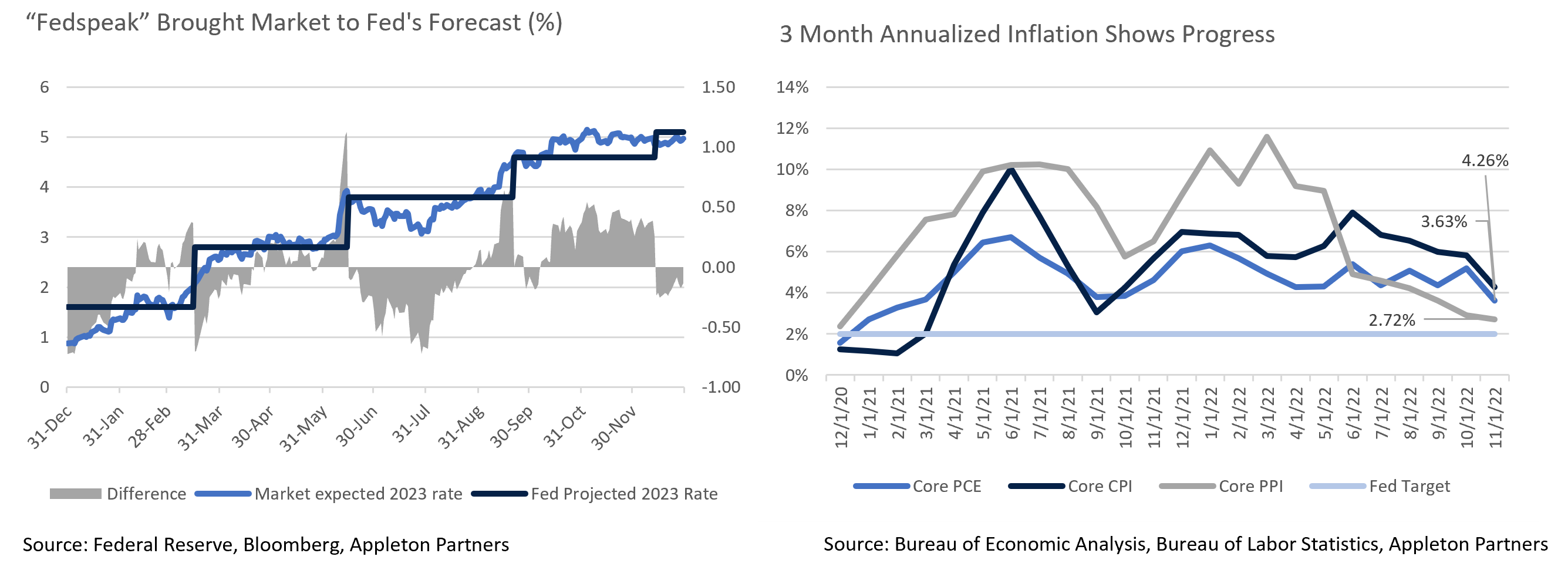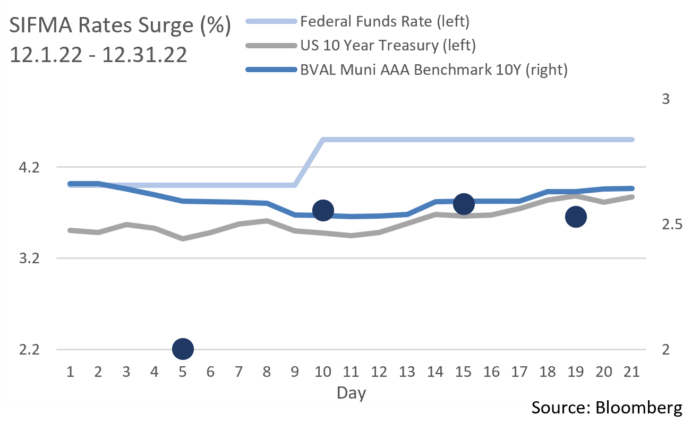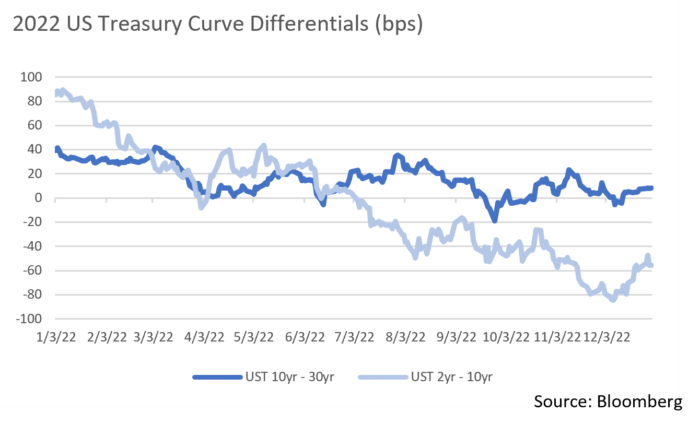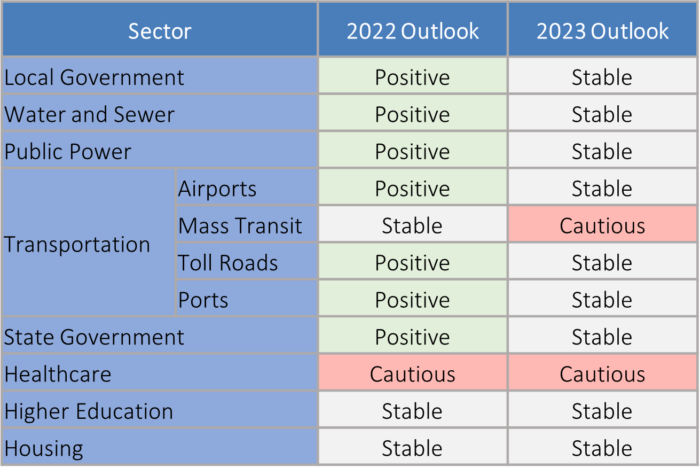Insights and Observations
Economic, Public Policy, and Fed Developments
- Nothing better underscores how year end is a symbolic and not actual change than a string of indistinguishable dreary days connecting December to January. Still, the turning of the year is a traditional time to take stock, and with that in mind we’re taking a bigger picture view than normal in our review.
- There is currently a broad consensus that the Federal Reserve will overtighten in their fight against inflation, causing a recession. And, for the bulls in the room, the strength of that consensus is maybe the best contrarian indicator for hope. However, the markets don’t really seem to believe the Fed will cause a recession. That’s a problem for valuations.
- Fed Chair Powell spent all of 2022 slowly raising the Fed’s projection of how high short-term rates would have to go. Throughout the year the market would eventually catch up with the Fed’s projection in time for them to raise it again, but rates were slow to move when the December dot plot showed the Fed expected a median 5.1% by the end of 2023. If there is any lesson this cycle it is when the Fed says they will do something, listen to them. However, right now the rates markets think the Fed will blink, a view which could be mistaken.
- Meanwhile, equity markets are pricing in consumer spending that may slow a bit but will still largely hold up. The problem here is the Federal Reserve is explicitly targeting “demand destruction,” to reduce inflation. For a while this fall, weak retail spending and consumption reports were an encouraging sign the Fed had made progress reducing demand. But, the Q3 GDP report’s final revision showed a surprise increase in personal consumption, and that initial reports had significantly understated consumer spending. This was followed closely by consumer confidence expectations indices hitting their highest readings since January. Markets are taking this as evidence the Fed is succeeding; to the Fed, strong spending is a clear sign they have not gone far enough.
- We believe three-month annualized inflation rates are the best way to control for the “base effects” that have made trailing twelve-month rates fall, overstating the Fed’s inflation-fighting progress. They show definite signs of improvement in the last several months. Nonetheless, wages are still hot, and as most salaried workers see annual adjustments in December and January, they should accelerate further. Social Security payments will also rise sharply in January. More money in consumers’ pockets almost always means more consumer spending, which in turn means there is a real risk inflation may accelerate again in the next couple months.
- All in all, the market’s 2023 outlook is based on contradictory views. Markets believe the Fed will ease its tightening earlier than they claim, consumer spending will remain robust, and even if demand does not fall in a supply-constrained economy, prices will. This is unlikely as even a “soft landing”, where only a mild slowdown tames inflation, seems like it will take further tightening. Our baseline forecast remains for the two hikes totaling 50-75bps which the market now expects. In less optimistic scenarios we think there is a real chance the Fed will ultimately hike rates higher than their latest 5.1% projection. Powell is very aware of the lessons of the 1970s and the pre-Volker era, and that too little tightening now may necessitate too much later.
- The good news is, the investment environment still looks much better than in 2022. Significantly higher carry return in fixed income is much better able to cushion additional rate hikes. We also still believe an aggressive Fed makes it more likely the peak Fed Funds Rate will occur this year, which should support equity markets as the year goes on. We just may see volatility until that time.

From the Trading Desk
Municipal Markets
- The municipal yield curve inverted in December, an anomaly that followed an earlier, more pronounced US Treasury inversion. Short Treasury yields have risen dramatically throughout 2022 on the back of aggressive Fed Funds rate hikes, whereas the longer end is constrained by persistent recession fears. Municipal yields typically more or less follow the Treasury curve’s lead, although perceived credit risk associated with longer maturities and certain technical factors usually prevent inversion. This year is an exception, as the spread between 2-year AAA and 5-year AAA issues stood at -8 bps at year-end, and front-end municipal curve inversion may persist until the Fed completes its tightening program.
- Further out on the curve, the greatest relative steepness has been extended to 10 to 13-year maturities. In our intermediate portfolios, at the margin we can barbell exposure in that part of the curve with much shorter maturities to maintain targeted duration while retaining a more attractive overall portfolio yield.
- Municipal/Treasury yield ratios, a common measure of relative value, are trading at low levels across the curve. Municipal supply has been highly constrained with 2022 new issuance down 19% vs. the prior year, a technical factor that has bolstered prices. New issuance and secondary market dealer inventory remains limited, and JP Morgan is projecting net negative issuance of $47 billion in 2023.
- Variable Rate Demand Notes (VRDNs), a tax-advantaged option for short-term cash, saw yields spike during December as crossover buyers abandoned the product in the face of rapidly rising Treasury yields. VRDNs are municipal instruments with coupons that reset daily or weekly, and the SIFMA Municipal Swap Index, a 7-day high grade index comprised of tax-exempt VRDN reset rates, can be volatile. Yields spiked above 3.50% towards the end of December, up from about 2.00% at the beginning of the month. As an active manager, we seek to take advantage of opportunities to enhance short-term income, and VRDNs can be compelling at certain points in times.

Corporate Bond Markets
- After reaching YTD highs in October, Investment Grade credit spreads began to tighten in the middle of October, a rally that was sustained through the close of 2022, although spreads remained steady in December. A 130 OAS print for the Bloomberg Barclays US Corporate IG Index on the last day of the year slipped just below the YTD average and helped to keep further monthly losses at bay. The Index returned -0.44% in December; the 4th best 2022 monthly return. This rally appears to be holding, and if the market’s 2023 “Fed Pivot” eventually materializes, it could be a positive for credit spreads.
- December’s primary market was very slow as issuers sat idle with limited windows of opportunity closing quickly. New supply of ~$7.5 billion was the lowest December figure since 2008. Consensus estimates of $10 – 20 billion of new debt fell well short as the typical holiday slowdown came sooner than usual. For the year, 2022 supply of ~$1.2 trillion was 16% lower than 2021, and elevated borrowing costs coupled with sustained inflation expectations have the potential to sustain pressure on the IG primary market.
- An inverted Treasury curve that reflects a spike in short rates along with recession concerns weighing on the long end began to ease in December. A flattening trade moved yields on benchmark bonds of 5 years and longer higher by an average of 35 bps. The gap between the 2Yr and 10Yr Treasuries closed to -55bps, well off YTD highs of -85 bps. By contrast, the spread between the two maturities at the beginning of the year was +87 bps. Looking back, and in contrast with the short end of the curve, longer dated bonds of 10 to 30 years have maintained a narrower range with an average spread of +15bps. Other recent periods of inversions, most notably June and September, were not as severe. A flattening curve would likely signal a weakening economy and, should this materialize, we expect there to be some value in the 4 to 7-year maturity range.

Public Sector Watch
Credit Comments
2023 Sector Outlook
 2022 was a turbulent economic year, one that produced significant changes in sentiment and downward revisions across most of our Municipal Sector Outlooks. Eight sector outlooks have been downgraded, although seven are now stable, a designation that anticipates steady credit conditions. Select bond issuers in these sectors could be attractive performers in an uncertain economic environment.
2022 was a turbulent economic year, one that produced significant changes in sentiment and downward revisions across most of our Municipal Sector Outlooks. Eight sector outlooks have been downgraded, although seven are now stable, a designation that anticipates steady credit conditions. Select bond issuers in these sectors could be attractive performers in an uncertain economic environment.
Our eight outlook revisions from positive to stable reflect softening consumer sentiment with a growing possibility of 2023 recession, coupled with a lack of further federal stimulus funding. On a positive note, reserves remain robust across many sectors following a period of strong performance. This offers a credit cushion and reinforces a stable outlook for nine of eleven sectors.
Of the nine sectors with a stable 2023 outlook, four exhibit similar credit characteristics due to their non-cyclical nature. These include state and local governments, water and sewer, and public power. Credit status in these sectors was resilient during past market downturns, and financial management remained prudent.
- Local Governments – Property taxes are typically a leading revenue source, and while rising interest rates have caused volatility in housing prices, local governments have many tools that can be utilized to mitigate housing related revenue swings.
- Water and Sewer – Given the essentiality of services and self-regulated rate setting, revenues have generally remained stable, and in general, few to no operational disruptions have been evident.
- Public Power is a defensive sector with low volatility due to services essentiality. Financial metrics should remain strong as past recessions have historically produced minimal financial impact.
- State Governments are coming off another year of relatively strong tax collections, and many states now enjoy record reserves. Although recent economic softening points to muted 2023 revenue performance, reserves provide considerable flexibility to mitigate weaker operating performance.
Ports and Toll Roads exhibited similar trends as these sectors faced curtailed operations during the early months of the pandemic before enjoying stark turnarounds.
- Toll Roads and Ports – Both sectors faced significant tailwinds over the past two years as the volume of goods transported increased due to easing of supply chain bottlenecks, pent-up demand, and high consumer spending supported by Covid-19 aid packages. Tailwinds are winding down though, as inflation and a looming recession have suppressed consumer sentiment, and inventory levels have mostly been replenished. Most bond issuers benefit from economic essentiality, strong liquidity, and enjoy recently bolstered financial positions.
The Healthcare and Mass Transit sectors carry a cautious credit outlook as they have experienced significant difficulties since the onset of the pandemic. With many consumer trends likely permanently changing, we see altered revenue generating ability.
The Mass Transit sector faced a ridership cliff at the beginning of the pandemic and has been slow to recover given a sustained prevalence of remote work. Many systems are expecting that ridership will never fully recover and are seeking new revenue streams to replace fare revenue. While mass transportation is critical to local economies, we believe the political landscape will present challenges as systems seek to raise new revenues in the coming years, leading to a cautious credit outlook.
The Healthcare sector has carried a cautious Appleton credit outlook for three years. The sector continues to be acutely challenged by inflation driven by both labor and supply shortages. Revenues have struggled to keep pace with expense growth as elective procedures have been disrupted. We expect margins to remain compressed in 2023.
Mass Transit and Healthcare have also been aggressively supported by federal aid since the pandemic and these stimulus funds are likely to be depleted over the next few years. This may compound issuer financial challenges and widen existing budget gaps.
Strategy Overview
Composite Portfolio Positioning as of 12/31/2022
Duration Exposure as of 12/31/2022

The composites used to calculate strategy characteristics (“Characteristic Composites”) are subsets of the account groups used to calculate strategy performance (“Performance Composites”). Characteristic Composites excludes any account in the Performance Composite where cash exceeds 10% of the portfolio. Therefore, Characteristic Composites can be a smaller subset of accounts than Performance Composites. Inclusion of the additional accounts in the Characteristic Composites would likely alter the characteristics displayed above by the excess cash. Please contact us if you would like to see characteristics of Appleton’s Performance Composites.
Our Philosophy and Process
- Our objective is to preserve and grow your clients’ capital in a tax efficient manner.
- Dynamic active management and an emphasis on liquidity affords us the flexibility to react to changes in the credit, interest rate and yield curve environments.
- Dissecting the yield curve to target maturity exposure can help us capture value and capitalize on market inefficiencies as rate cycles change.
- Customized separate accounts are structured to meet your clients’ evolving tax, liquidity, risk tolerance and other unique needs.
- Intense credit research is applied within the liquid, high investment grade universe.
- Extensive fundamental, technical and economic analysis is utilized in making investment decisions.





